2 Volumes
The Franklin Institute of Philadelphia
Awards of the Franklin medals.
Gilded Age
They made their fortunes in the West, but spent them in Philadelphia. Until they settled in the West, themselves.
Achievement Awards: Franklin Institute
Franklin Institute Awards Week
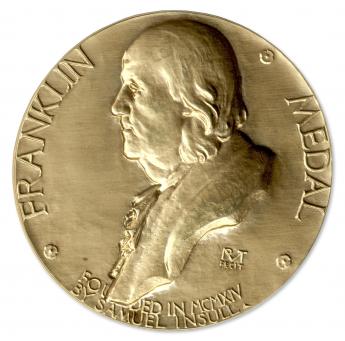
|
| Franklin Medal |
The Franklin Institute began giving medals for scientific achievement in 1824. Since Franklin died April 17, 1790, it just goes to show it takes a while to recognize genius in your own midst, even when the genius would soon come to be known as the "most remarkable man who ever lived." Indeed, he would come to be known as the founder of the American diplomatic corps, and even suspected as the man who changed his mind about King George III, thus quite plausibly becoming the person who started the Revolutionary War, who devised the essence of the Constitution which has lasted longer than any other Constitution, revised the Postal Service as Postmaster, started one of the Ivy League Universities, wrote the best-selling autobiography, invented the Franklin stove, and became President of Pennsylvania. Starting nearly penniless, he eventually became one of the richest men in the country. Looked at from a distance, it also might be possible he was the greatest Rain-maker in our history, even though he spent 28 years in England and France.
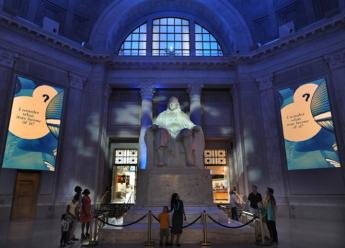
|
| Franklin Institute |
But what he was without doubt or quibble, was a scientist. He essentially invented electricity, explained its nature, and started it on its way as central to the Industrial Revolution, by inventing the lightning rod. One of the commonest quotes about him is, if there had been such a thing as a Nobel Prize, he would have won it. But you seldom hear that particular quote around the Franklin Institute. Because the idea of awarding a prize for scientific achievement was not invented by Alfred Nobel at all, but rather by the Franklin Institute in 1824, almost a century earlier. It all started with the Bower Award and continued for nine other prizes, generally referred to as Franklin Medals in nine separate scientific fields. Unlike the Nobel prize, its scope does not extend beyond science, and even in the case of the Bower Award, it honors a business leader who exploited a scientific advance and made a business out of it.
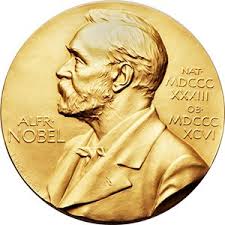
|
| Nobel Prize |
The Nobel prize became the center of Scandinavian social life by utilizing the Kings of Norway and Sweden, justifying white tie and tails, and by giving a large financial reward, which has been greatly augmented by an investment advisor in Wilmington, Delaware. This year, the Franklin Institute decided to imitate that particular feature, awarding $10,000 apiece to the awardees, and hoping that generous American donors would get the point, that a little cash will quickly equalize a century's lead in astutely recognizing scientific talent. Most of the Nobel Prize winners had previously won Franklin Medals, so this year the trustees recognized the value of something tangible, to make a real race of it.
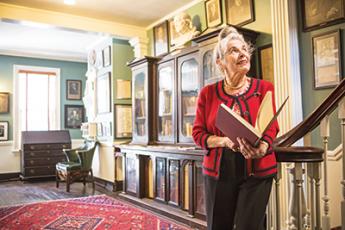
|
| Janice T. Gordon |
The Franklin Institute only holds eight hundred people, an audience limit which is exceeded before a single invitation is put in the mail, and the attendance price has risen, accordingly. That was almost solely due to the work and influence of Janice T. Gordon, who rose to be chairman of the event but kept her attention focused on competitiveness with the Nobel, and award ceremonies in general. Consequently, the audience size level is limited by the seating capacity, a phenomenon first noticed with the Philadelphia Eagles Professional Football team. The football season tickets absorb the whole capacity of the site, so local people tend to get excluded. No one gets to see a football game except out-of-towners with season tickets. It will be interesting to see what Philadelphia does with this problem, but you can be sure something will be done. The Philadelphia Assembly solved this problem by sending tickets only to descendants of former attendees at the original Assembly Ball in the Eighteenth Century, but that limits the attendance to Philadelphians--a problem in the opposite direction. Keep tuned. In other articles, we plan to describe presentations so this audience will come to understand why this event is so popular. But the goal was set by the Kentucky Derby; the first horse to win the two-minute spring races sets the pace for others to match. Even if the Kentucky Derby horse breaks his ankle, his name is the one you remember.
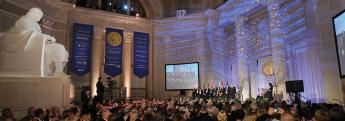
|
| Franklin Awards |
The Franklin award winners have become more national and international with time. So, increasingly the awardee's travel has gradually increased, to the point where a dinner for the award seems inadequate for such a trip to get it. So, the award ceremony now stretches to almost a week. On the first night, the awardee meets with his sponsors and fellow awardees. All day the second and third days is spent visiting high school students, for the purpose of increasing their appetite for science as a career. Selected for their promise, these students actually get time to visit with scientists at the peak of their careers, ask questions, and decide whether science is the career for them; from all reports, this is a very successful experience. On the evening of the second day, a fancy dinner is provided at a neighboring hotel, and frivolity is expected. On the third night, a television announcer is recruited as master of ceremonies, the ladies wear their jewelry, and the gentlemen are in formal attire. The awardees and their sponsors are announced, one by one, get medals placed around their necks, and watch a professionally televised summary of their work, followed by a dinner for eight hundred dressed-up Philadelphians. And on the fourth day, an all-day symposium is held by colleagues selected by the awardee for an in-depth, state of the art, presentation of the awardee's significant area of work. There are nine such concurrent seminars, followed by a lunch. Whew! By the time it's over, the guests really know something in depth, explained by the most eminent scientist in the field. And, judging by the number of awardees who return to attend subsequent award ceremonies, they really have a good time.
Award Seminar # 3940: Douglas C. Wallace, PhD
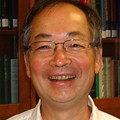
|
| Dr. Aiwu Cheng |
Although others spoke, the Awardee chose four scientists in his field to present the cutting edge of it. And at far greater length than there is room to summarize here. The first was Aiwu Cheng (Shey-Shing Sheu), originally from Taiwan, but now Professor of Cardiovascular Research at Sidney Kimmel Medical College, Thomas Jefferson University. Dr. Cheng defined the role of the mitochondria to facilitate the conversion of ATP to ADP, essentially burning hydrogen by combining it with oxygen in the cell. In the case of cardiac muscle, ATP is exhausted in less than two minutes, and the cell will die. The cell responds by isolating the dead cell, and if enough of them die, the whole organism will die. The outcome is seen as the disease of sudden death in a person with an apparently healthy heart, but it probably plays a role in heart failure and death in general. In the intestinal tract, the bowel stops working, resulting in distension and fluid levels. When the person loses weight and then partially regains it, superoxide is released, probably causing distant damage to other cells by causing apoptosis. Dr. Cheng very kindly substituted for Sir John Walker, who was unable to fly to America on doctor's orders.
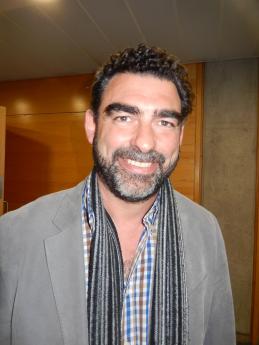
|
| Nick Lane, Ph.D., |
The second speaker was Nick Lane, Ph.D., Professor of Evolutionary Biochemistry, University College London, notable for theoretical books he has written about mitochondria, particularly emphasizing their probable role in sexual reproduction. Although a few ocean species differ, it is usual in our form of life to have a single set of nuclear DNA, and many sets of genes for mitochondrial DNA. The explanation seems to be the sperm cell contains no mitochondria, so mitochondria and the diseases they transmit are only carried by the mothers. Although some rare animals do things differently, mitochondria are exclusively transmitted by the females and their action on organ differentiation is controlled by the organ ratio of mitochondrial DNA to nuclear DNA. Essentially, that takes care of life, death, and sex.
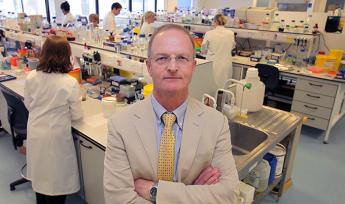
|
| Sir Douglass M. Turnbull, |
The third speaker was also a Knight from England, Sir Douglass M. Turnbull, Professor, and Director of the Wellcome Trust Center for Mitochondrial Research, Newcastle, UK . A practicing pediatrician, he is credited with discovering a mutation of mitochondria, the diseases it causes, and the legality of the 3-parent cure of the disease. The cure involves removing the ovum from the mother, sucking out the nuclei with a pipette, and inserting the mitochondria from another mother, with fertilization by the father's sperm along the way. The result is a baby with two mothers and a father. Apparently, such operations require the approval of Parliament under the British medical system, and it took seven years of hard work to persuade all the committees to approve. This talk was given the day after the Trump bill discarded most of Obamacare, and loyal Englishman that he is, Sir John gratuitously commented that it illustrated the superiority of the British system. It was a little hard to follow his reasoning, however brilliant his research. He did comment that one baby in six carries mitochondrial mutations, so his own work will undoubtedly become famous.
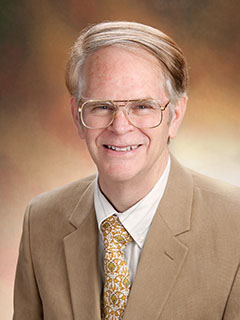
|
| Douglas C. Wallace,Ph.D., |
And the final scientific speaker was Doug Wallace, himself. Douglas C. Wallace, Ph.D., Professor, and Director of the Center for Mitochondrial and Epigenomic Medicine at Children's Hospital of Philadelphia. Doug fired scientific discoveries at his audience like a fire-hose, including the female exclusiveness of mitochondrial transmission, the utility of following tribal migrations around the world by sampling mitochondrial mutations, and the discovery that mitochondria were probably once bacteria which somehow got lodged within yeast cells. The significance of this point is that yeast cells are unable to burn oxygen (make ATP) and acquired what was originally the exclusive ability of plants. In any event, there are more mutations within the 37 mitochondrial genes than in the thousands of nuclear ones, and hence a much greater chance of finding cancers (or the cure for cancers) in one place than another. The practical difference between curing one common expensive disease, versus many rare ones, must be obvious. Children's Hospital must be proud of this humble man.
2 Blogs
Franklin Institute Awards Week

Award Seminar # 3940: Douglas C. Wallace, PhD
 Mitochondria, you idiot, Mitochondria.
Mitochondria, you idiot, Mitochondria.